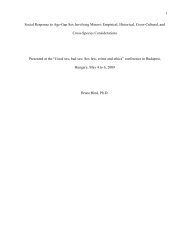Infant and Child Sexuality: A Sociological Perspective - Ipce
Infant and Child Sexuality: A Sociological Perspective - Ipce
Infant and Child Sexuality: A Sociological Perspective - Ipce
Create successful ePaper yourself
Turn your PDF publications into a flip-book with our unique Google optimized e-Paper software.
girls never associate in the absence of chaperones. (Ford <strong>and</strong> Beach,<br />
1951, p. 183).<br />
Among preadolescents in other societies, on the other h<strong>and</strong>, the<br />
Maori, the Trobri<strong>and</strong>ers of Melanesia, the Chewa of Africa, <strong>and</strong> the Lepcha<br />
of India among them, it is common for girls <strong>and</strong> boys to be active<br />
participants in full sex relations several years before puberty <strong>and</strong> in<br />
some cases much earlier. In permissive societies there may be active<br />
instruction in sex matters by older members of the group. (Ford <strong>and</strong><br />
Beach, 1951, p. 174-177, 189-192).<br />
In the United States, parents, the church, the school, courts, <strong>and</strong><br />
other agencies are influential in defining <strong>and</strong> controlling sexual behavior.<br />
For example, the school--grade school, junior high school, high<br />
school--is permissive in its attitudes toward heterosexual activity, in<br />
that it plans dances <strong>and</strong> parties for boys <strong>and</strong> girls, but it is also restrictive<br />
in that chaperonage is commonly provided <strong>and</strong> erotic behavior<br />
is proscribed.<br />
I remember one of the chaperones.... Whenever<br />
she found a couple dancing a little closer than<br />
she thought was proper, she would shove the<br />
ruler between the couple <strong>and</strong> say, “Six inches<br />
apart, children.”<br />
In the United States, the school takes a proprietary interest in<br />
the total life of the student <strong>and</strong> is sometimes more restrictive than<br />
are the parents.<br />
The elementary school administrators were very<br />
upset <strong>and</strong> concerned when they learned of our<br />
boy-girl parties arranged by our parents.<br />
Mixed Parties<br />
Mixed parties are something of a new phenomenon added to the sexual<br />
scene in preadolescence. They are a fairly common middle-class phenomenon.<br />
Heterosexual parties are referred to in the literature as<br />
“group dating.” (Martinson, 1960, p. 73-77). Such parties often precede<br />
or signal the beginning of paired dating. These parties may be a<br />
part of school activity, they may be planned by organizations of girls,<br />
or they may be private parties planned by the young people themselves<br />
or by their parents.<br />
Many of our parents would arrange for boy-girl<br />
parties in their homes, spending their evening<br />
upstairs while we (age 10) were left quite<br />
unchaperoned in the basement.<br />
As far as I can recall, the initial party of<br />
consequence was a mixed birthday party given in<br />
honor of one of the girls. This, more or less,<br />
started the run of parties that began to take<br />
place nearly every Friday evening during the<br />
school year. The kids attending these home parties<br />
weren’t ever paired off in couples but were<br />
83
















